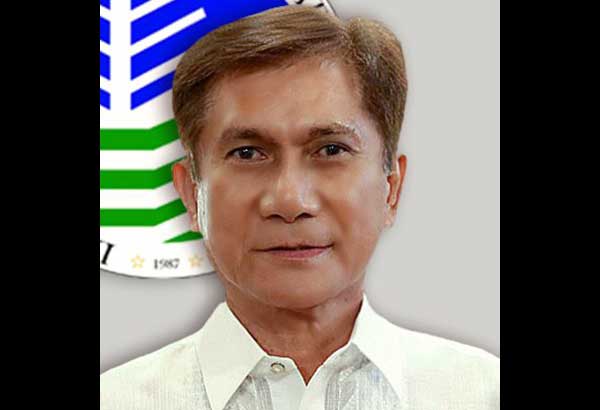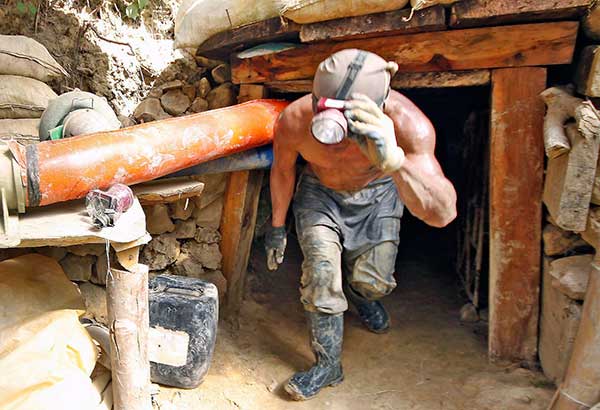Mining industry remains in a pit of uncertainty

Cimatu
MANILA, Philippines - The major regulatory changes implemented by the Duterte administration has created uncertainty for the mining industry.
The sector has come under pressure to shape up or close down as President Duterte vowed to put a stop to irresponsible mining.
While former environment chief Gina Lopez, whom stakeholders considered as their worst nightmare, is now out of the picture, the industry remains in disarray.
 A small-scale miner takes a break from extracting gold.
A small-scale miner takes a break from extracting gold.The local mining industry faced a rough patch during President Duterte’s first year in office, starting with the appointment of environment advocate Gina Lopez as head of the Department of Environment and Natural Resources. She issued administrative orders that hurt the industry.
“We had a really tumultuous year because of the appointment of Lopez. Tumultuous in the sense that she ordered the closure and suspension of 28 operating mines and a ban on open pit mines,” Chamber of Mines of the Philippines Legal and Policy vice president Ronald Recidoro told The STAR.
“It was a rocky start because of Sec. Gina’s arrival. But somehow the industry also needed that shake-up because we can only allow responsible operations in the country,” said JB Baylon, Nickel Asia vice president for corporate communications.
The industry is getting jittery anew because of Duterte’s recent announcements he would tax mining fims to death if they continue to neglect their duty to protect the environment.
“As we see it, President Duterte relies heavily on his secretaries and he just let Gina do her thing. He wanted to shake up the mining industry and we were really shaken. He saw that there were mines that were violating (environmental laws) but he might be confusing the legitimate miners from the illegal ones,” Recidoro said.
“He might just be seeing mines that are actively doing mining and might be disregarding our rehabilitation efforts. Mining does not stop at extraction, mining stops when the area is rehabilitated and turned over either to the government or the community,” he added.
No clear path yet for mining
While Lopez’s orders have not actually been implemented, the industry believes her ditectives created a lot of uncertainties not just on the operating mines, but also on prospective investors looking at the Philippines.
“Other people particularly investors are asking what’s going to happen in the Philippines and frankly, we don’t know. There’s still a lot of uncertainty until now and even without Lopez there, there is still no clear path that’s laid out for the mining industry,” Recidoro said.
“In this administration, we haven’t seen any indication where it wants to take mining not even on revenue sharing. The effort should be more of enhancing collection of tax from the illegal miners,” he said.
Data showed that around $22 billion worth of projects are already in the pipeline and are hanging including big ticket items like the $5.9 billion Tampakan project and the over $2 billion Silangan mine of Philex Mining Corp.
“Globally, the appetite for exploration has really gone down, then add the uncertainties in the Philippines. We might be losing out on opportunities,” Recidoro said.
“Global demand for our exports must go up meaning prices for gold, copper and nickel should increase. If that goes up, that would also increase interest in the Philippines since we are a major source of minerals,” he added.
But despite this, investors would have to consider the country’s policy regime and how viable is it to put up a mine in the Philippines.
“If there’s nothing happening in the last six years, the ripple effect of that is 15 years down the line. There will be a gap because mines are closing and yet no new ones are opening,” Recidoro said.
Trusting Cimatu
While the industry lauds Environment Secretary Roy Cimatu’s stand on responsible mining, stakeholders are still guardedly optimistic because of their experience with Lopez.
“A lot will depend on Cimatu’s direction and vision for the industry. He seems to be a more level headed secretary. He has preliminarily said some positive things about responsible mining so we are just waiting for his action now on key issues,” Recidoro said.
Cimatu has been quite aloof in answering media queries, saying he is still trying to learn the ins and outs of the sector.
“We have to give him more time because he does not really have an exposure on environmental laws, mining is not just the portfolio of the DENR. We would rather have him study it well than rush it and have more adverse decisions,” Recidoro said.
“It’s a very complicated issue that will require a lot of study. It’s already a complicated issue and Gina made it more complicated. It will require Cimatu to overturn the decision of a previous secretary which is politically very difficult. We’re just giving him all the time he needs,” he added.
Recidoro thinks that Cimatu’s not so quick action in dealing with Lopez’s orders means he is just being careful.
“Now that Secretary Cimatu is in and given the ongoing reorganization inside the department, these have calmed the noise and I believe the industry would be able to recover,” said listed Global Ferronickel Holdings president Dante Bravo.
The industry is also happy with the appointment of engineer and lawyer Wilfredo Moncano as head of the Mines and Geosciences Bureau.
“We all want consistent regulations, that’s what we’re asking ever since. The inconsistent implementation of the mining act has given rise to all our problems,” Recidoro said.
What government needs to do
The administration has barely scratched the surface and it has five more years to prove its economic targets but for stakeholders, the government should stabilize the policy environment and send the right signal to investors and the current players to encourage them to expand.
“We need stability because the global market is also unstable, when I say stability I mean internally in terms of policy. We need stable policies that allow responsible operations in clearly delineated areas under terms that are mutually beneficial,” Baylon said.
“We expect the government to encourage more investments in the industry because it can be one of the important growth drivers of our economy, particularly in terms of foreign direct investments and employment. It can provide a significant amount of revenue to the government, as well as help develop communities, without sacrificing environmental protection,” Bravo said.
While the share of the industry to the total economy is a minimal 0.7 percent, this can be increased if the government will encourage more investments particularly in gold and copper which are more permanent.
According to geologist and professor Carlo Arcilla, about 80 percent of gold production is produced by small scale mining which is plagued by non-payment of taxes and is considered as the real problem of the industry.
“The share of mining revenues must shift in favor of the majority going to the local governments because they host the minerals, and their remote access means they were not cared for properly by government until mining operations began. Mining companies must also be allowed to pay taxes directly to LGUs to establish cadence between the impact and rehabilitation and its earnings,” said Arcilla, professor of earth sciences at the University of the Philippines.
Mining occurs in less than 0.3 percent of the total land area in the Philippines. While exploration applications cover 40 percent of the country, many no-go zones and uneconomic mining conditions prevent mining activities.
“While mining contributes less than one percent to national GDP and employment, its occurrence in equally less than one percent of the land area means simply that where mining occurs, it is very significant,” Arcilla said.
Mining comprises the most important economic activity in MIMAROPA & CARAGA where its contribution exceeds 20 percent of the region’s GDP.
“All the minerals in the Philippines are owned by the state. The current sharing of revenues needs review in view of different metals requiring different mining methods, different levels of integration, and different marketing methods,” Arcilla said.
Mining stakeholders are also calling for the development of the minerals industry roadmap.
But COMP is not quite optimistic about the progress of the downstreaming industry in this administration.
“The move now is to strengthen the steel industry but in terms of linking mining to the steel industry, it’s one of the things that we would like to see. We need to find partners who can do the processing with us. Mineral processors are saying it’s very hard to turn a profit in the Philippines given the high electricity, red tape, and other external factors,” Recidoro said.
“These things have to be fixed if we want to have a viable downstream processing industry. It has to be a multi-agency thing and a multi-departmental approach,” he added.
Recidoro, meanwhile, believes that mining can contribute a bigger chunk to the economy if it will be in full steam.
“It can add another one to two percent in GDP. It’s a big thing already and we can do that consistently for the next 20 years. Once we start, we will be there for the next 20 years and more,” he said.
- Latest
- Trending






























